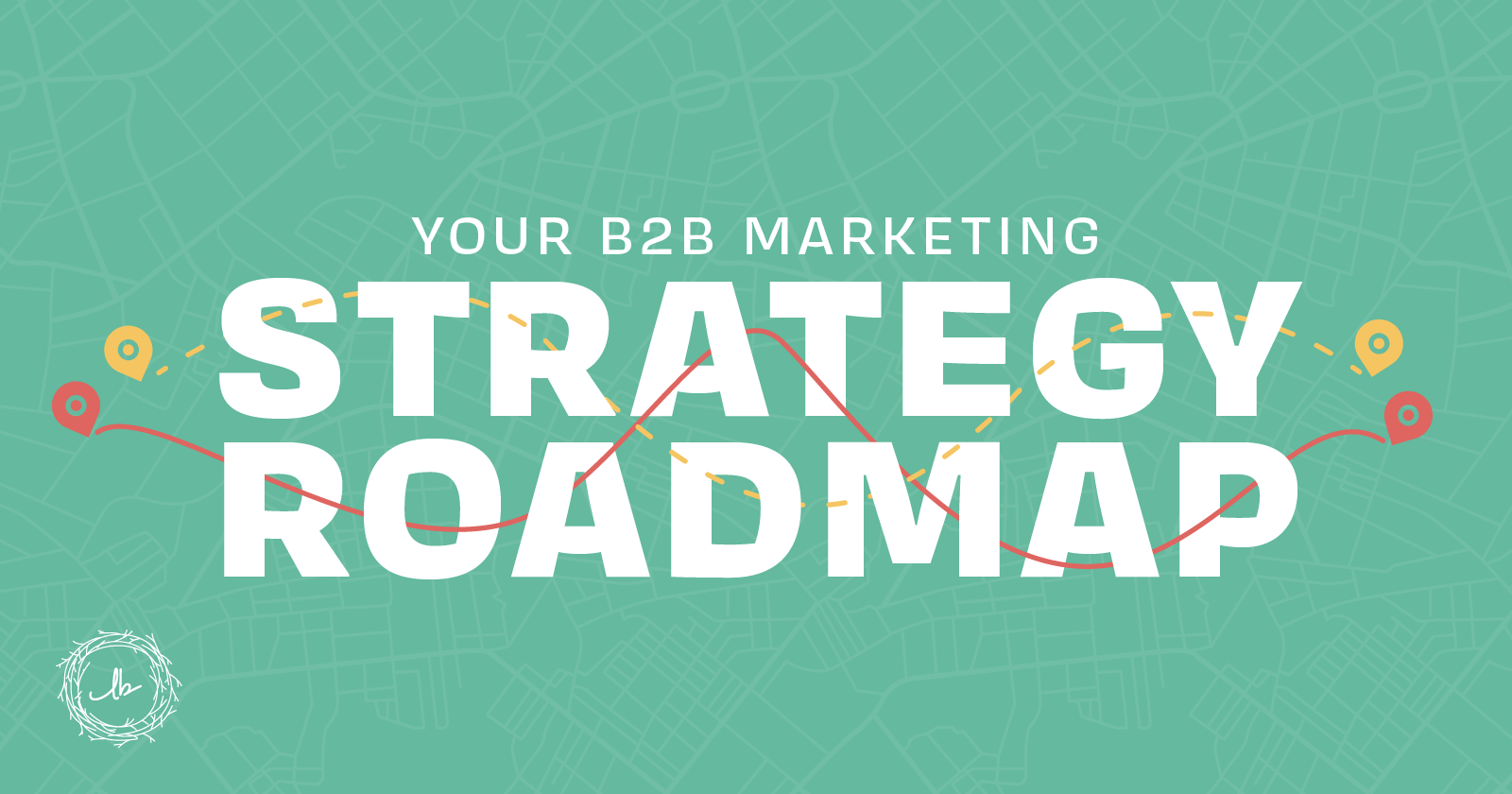Humans work better with clear direction, and so will a marketing plan. While most marketing templates or strategy roadmaps are for businesses that sell goods to consumers, this roadmap is for the sometimes convoluted, occasionally complex task of sparking interest within and amongst other businesses. While it’s not easy to convert leads from a business audience, it’s not impossible.
According to Hubspot, just 8% of salespeople say that their marketing teams generate high-quality leads.
The SOAR™ System is predicated on the agreement that for a plan to be successful it must be these four elements - Strategic, Organized, Accountable, and Repeatable. From this understanding, we created a reliable framework for a B2B marketing plan that will engage business professionals while generating leads and setting the stage for great business relationships.
B2B (business-to-business) marketing requires a nuanced approach. Often when our team is called in we find that teams have been doing some right actions, but often they have them in the wrong order which is minimizing the impact. So it is not a matter of just doing right actions, but understanding the order that will bring the most success. Here we explore how our SOAR™ system can be applied in theory. You can crib from our hard work - even if you don’t work with us as an agency. Regardless of the details or your level of skill in execution, this framework should be done in the right order for maximum benefit and here we provide more detail on the four phases and provide some insight into what needs to be accomplished at each stage.
Strategy
80% of new leads never translate into sales. — Invespcro
Before considering any action, tactic or platform, the most important step includes clarifying exactly whom you seek to serve, your goals and which of your existing assets can be harnessed for success. An easy way to begin this process is by doing a SWOT analysis of your business to determine goals and overall trajectory. Then, you are able to pin down your specific buyer persona(s) to create an inbound marketing strategy that is targeted and effective. An even easier way is to have us to this for you, but when that is not in the cards, we also created this amazingly helpful ideal buyer persona template!
 S.W.O.T. not to be confused with S.W.A.T.
S.W.O.T. not to be confused with S.W.A.T.
Define (or redefine) your Buyer Persona(s)
Everyone is trying to reach someone. Because of the competitive, technology-focused and fast-paced world we live in, your audience is larger than it's ever been. So, in order to reach people effectively, marketers need to create an inbound strategy that is targeted and effective — a strategy that reaches the people who matter most for business success. The right buyer persona will give you a complete understanding of the foundation of your marketing efforts.
50% of prospects aren’t a good fit for what you sell. — Sales Insights Lab
Lucky for you, buyer personas are our specialty. The definition of a buyer persona is simple — they’re a semi-fictional character that represents your ideal customer based on detailed research of your actual customers. Personas look deeper at your target audience to uncover the needs and wants of your ideal buyer.
 Let us help make it simple.
Let us help make it simple.
Buyer personas reflect your best customer relationships — relationships that generate the most revenue, with minimal opposition, over the longest period of time. Think about your best customers. How do they communicate? Are your goals aligned? These are the clients that you are trying to reflect with your personas. They are not your dream clients. They are your best clients. If you are smart and Download the template AND get it done, please remember that you should not then put them in a drawer for safekeeping. They need to live out in the fresh air of the office - being seen and connecting with everyone responsible for brand growth.
Buyer personas can and should be utilized across your entire organization. Sales departments can use them to focus on how to best sell to qualified leads. Management can use them to decide where to properly allocate resources. It even benefits new hires during onboarding to understand the clients that they will soon be working with. By orienting your team around your ideal persona you assure that your entire organization is working together to reach the right client.
SWOT Analysis
A SWOT analysis stands for Strengths, Weaknesses, Opportunities and Threats, all of which provide fair insights into how to optimize your marketing. It’s a strategic planning technique that puts your business into perspective and helps to identify areas for improvement to maximize opportunities, while also determining factors that might hinder your success. A SWOT analysis helps to determine which initiatives are worth executing, which challenges or opportunities to seek right away or what obstacles you might face.
Setting goals and reaching said goals are two very different things. Whether you have short-term or long-term goals, using a strategy roadmap can help you get on your feet and manage the process, increasing the likelihood of sustained success.
Let us show you how to map out a B2B marketing strategy and develop the actions necessary for execution. Every company needs a unique flight plan. This strategy roadmap will help you clearly describe goals, apply focus and set a deadline for meeting them. To accomplish this, focus on creating SMART goals.
Write SMART Goals
SMART Goals are Specific, Measurable, Attainable, Relevant and Time-Bound.
- Specific: Make your goals as short, concise and specific as possible. Ask yourself questions like “How?” “What?” and “Why?” If your goal is to improve your marketing, look at your key performance indicators (KPIs) and choose one you want to improve.
- Measurable: Make your goal measurable by asking "How much?" "How many?" or "How will I know when it's accomplished?".
- Attainable: Make SMART goals that are actually attainable and realistic for your team to accomplish.
- Relevant: A relevant goal could be something along the lines of, “increase distribution channels by X%” or “increase profit margin per unit by 5%” — a goal that matters to the company and is attainable by the company. Considering the relevancy of each goal is key to growth.
- Time-Bound: You need to ensure you have a timeline for meeting those goals. For example, if you decide your goal is to increase distribution channels, then you need to know when you will accomplish this in order to know when to begin working on a secondary goal to meet new demand.
Mind your KPIs
A key performance indicator measures how your company is performing directly related to key goals and objectives. Essentially, KPIs are measurable metrics that gauge overall performance over time.
There are various types of KPIs you can track:
- Customer Acquisition Cost (CAC)
- Lifetime Value of a Customer (LTV)
- Return on Investment (ROI)
- Return on Ad Spend (ROAS)
- Marketing Qualified Leads (MQL)
- Sales Qualified Leads (SQL)
Determine Content & Platforms
Content marketing has become one of the most powerful B2B digital marketing strategies for businesses of all sizes and industries. However, when it comes down to developing your strategy, it can be difficult to decide which types of content marketing you should use to grow your business.
 Nobody puts the pressure on quite like Chef Ramsey, but don't worry. We're here to help.
Nobody puts the pressure on quite like Chef Ramsey, but don't worry. We're here to help.
B2B customers use 10 different channels during their decision-making process. —McKinsey & Company
As a marketer, there are many types of content at your disposal to reach your audience. In order to best capture their attention, you should utilize various content including blogs, social posts, videos, podcasts, emails and digital ads. In order to see the best return on investment, your efforts need to be targeted to your buyer persona. A successful digital content strategy will attract your target audience at every stage of the funnel and keep them engaged, even after a purchase.
In order to determine the best type of content your persona will engage with, start by asking yourself some questions—
- Where is our buyer persona spending time online?
- What type of content does well on each platform?
- What does content look like for our brand?
- How will we manage content creation and publication? (Hint: you’ll want a CMS)
Determine your CMS/Automation Platform
A CMS, or Content Management System, is a software application that allows users to build and manage a website without having to code it from scratch or know how to code at all. With a
CMS you can create, manage, modify and publish content in a user-friendly interface. The design and functionality of your site are customizable with downloadable or purchased templates and extensions. Sounds like a dream, right?
A CMS is made up of two core parts: a content management application (CMA) and a content delivery application (CDA). This allows you to make changes, install extensions and edit your site without all of the back-end hassles.
There are plenty of CMS options available, one is sure to fit your company’s unique needs. Depending on the cost, your budget (annual or monthly) and the features you want to utilize, you can identify which CMS you would like to utilize and at what level. A few common examples: Hubspot, WordPress, Mailchimp, and Pardot.
Pssst! Check out this article: 15 Best and Most Popular CMS Platforms in 2022 (Compared)
When choosing a CMS, you’ll need to understand the features each one offers, in comparison to the ROI it provides. However, you cannot fully determine your ROI without first setting your budget and executing a plan to make it happen, as is part of all B2B digital marketing strategies.
We’re a Platinum HubSpot shop, so we’d love to give you a spin in that ride. But we don’t bleed orange (if you know the brand, you’d think that is funny). You need to make a logical decision about what fits best into your marketing technology (MarTech) stack. Too often people make a short-term decision on this based on price without considering the long-term consequences of getting this important step right.
Whether with your team or ours, it’s time to shift focus to execution and integration — creating a sustainable cycle of lead generation.
Set Your Budget & Execute.
Determine what you need. Whether it be website redesign, rebranding, photo/video shoots, software or advertising, make sure to align your budget with your marketing goals. Ask yourself, “Does investing in X directly or indirectly push the company toward achieving one of its SMART goals?” From here, contract writers, book a shoot, set money aside for monthly advertising — execute the budget spend with SMART goals in mind.
Begin Content Creation & Automation.
Over half of B2B buyers rely on content to research their buying decisions. — Demand Gen Report
When people have a question they break out what I call their “Google thumbs”. Do we use our thumbs for much else these days? When not hitchhiking, pretty much the only thing I use my thumbs for are pressing inappropriately named thumbtacks and Googling things. B2B professionals are no different. So it follows that the content you create for your company should be roughly 90% evergreen and 10% timely. Evergreen content has sustained interest over time and is always fresh — meaning no dates or time stamps. Evergreen content is crucial to a successful B2B digital marketing strategy so that a company can sustain consistent posting and your expertise is properly ranked on search engines.
What do you do with this great evergreen content? Get it published, of course! This is where a Content Management System or Marketing Automation Platform comes into play. A strategy roadmap wouldn’t be complete without them. Utilizing a CMS or MAP will help you automate your marketing and sales to generate more leads, close more deals, accurately measure your marketing success and get more sleep. It means publishing content and having the right calls to action (CTAs) and having automated steps happening when people click through what you’ve written.
 As we like to say at Little Bird Marketing — put pressure on systems, not people!
As we like to say at Little Bird Marketing — put pressure on systems, not people!
Analyze
Use third-party analytics such as Hubspot Analytics, Google Analytics, SEM Rush or GTmetrix to gain insights and measure the performance of the company’s marketing campaigns. Most of these offer built-in reports and dashboards. Track and break down your findings or reports by CRM and analyze your website’s performance. From there, shift your marketing efforts depending on revenue and audience trends. You won’t know if your B2B digital marketing strategies are working unless you pay attention to the analytics and data.
61% of marketers rank lead generation and traffic as their number one challenge. — Hubspot
Do you want to convert leads? If the answer is yes, then you’ll need to have solid B2B marketing strategies in place and commit to learning from your wins and failures. Evaluating what is working and what is flopping is key to putting a bow on your marketing efforts.
The key to creating a successful marketing plan is a strategic, organized, accountable and repeatable marketing template. The SOAR™ System is designed to help busy leaders create a sustainable lead generation system within 90 days so they can remain confident in the growth of their company without losing focus on their other responsibilities. This is not a quick fix and it is a big commitment. We like to take it pretty seriously.
This roadmap can help you to create and execute a plan, but if you need help along the way, the “peeps” at Little Bird Marketing are here to help!

DO-IT-YOURSELF |
DONE-FOR-YOU |
Can your internal marketing department and our SOAR System coexist? Absolutely!In the Do-It-Yourself Flight Plan, we provide the framework, structure and training needed to execute a successful annual marketing plan.
|
What’s better – hiring 1 person with a few skills? Or hiring 1 team of experts with a plethora of skills?With the Done-For-You Flight Plan, our team becomes an extension of yours. In addition to the framework and structure of the DIY plan, this plan includes monthly execution of all marketing deliverables. |








Let Us Know What You Thought about this Post.
Put your Comment Below.